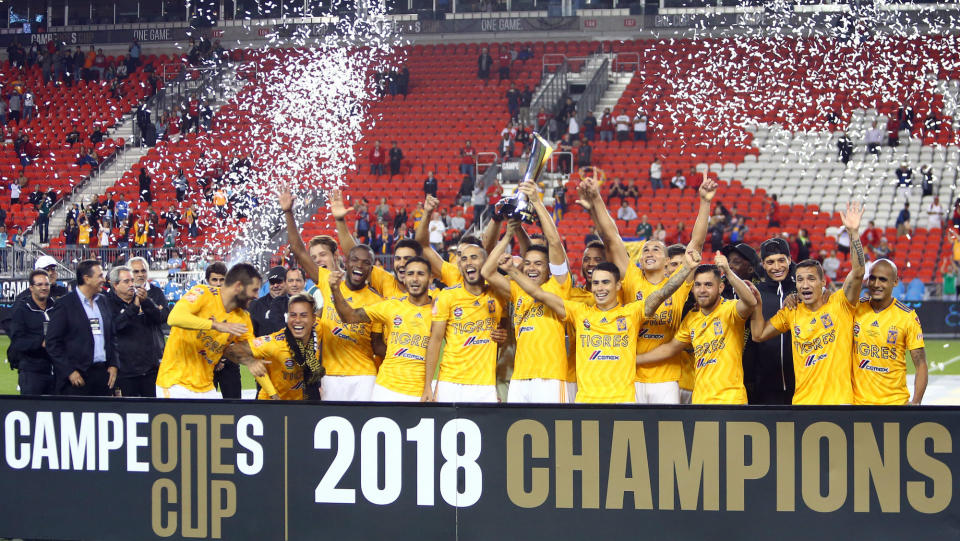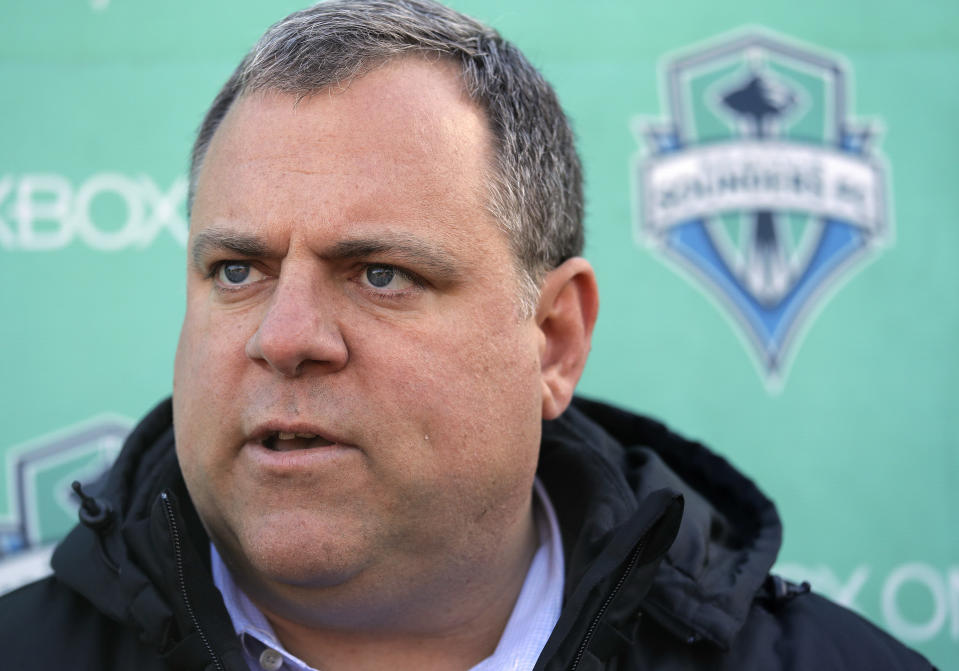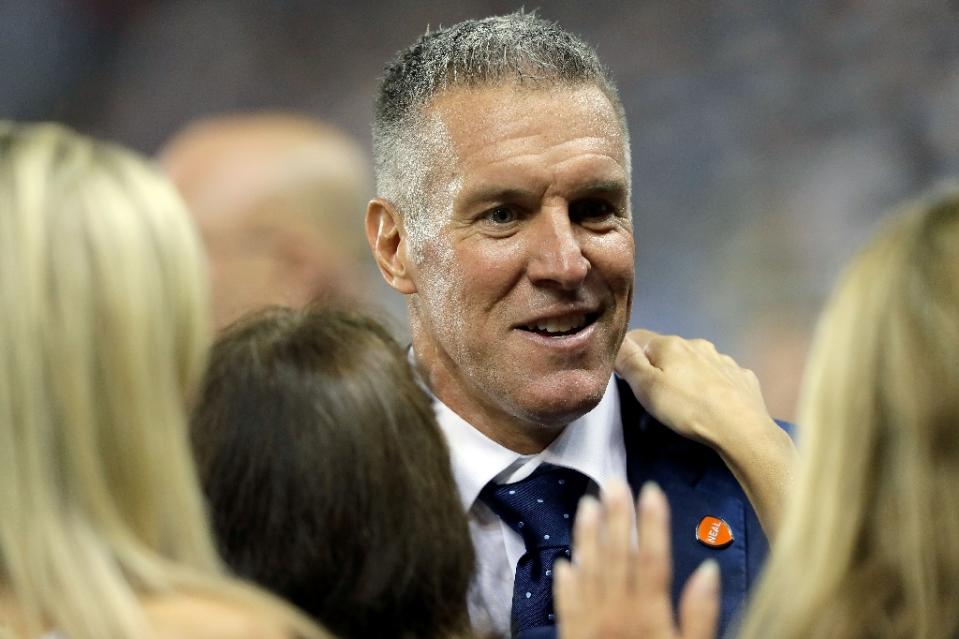McIntyre's 23 Thoughts: USA vs. Mexico on club level, streaking Sounders, Vermes on USMNT

Doug McIntyre’s weekly MLS column, 23 Thoughts, parses through the latest insights and inside info from around American soccer.
Say what you want about Wednesday’s inaugural Campeones Cup between defending MLS champion Toronto FC and Tigres, their counterparts from Liga MX, but it meant something. Maybe not to TFC fans, who can’t really be faulted for staying away from TFC’s BMO Field in droves. But to the teams involved, it actually sort of did.
Both managers sent out close to first-choice lineups. For a Toronto side desperately trying to make the MLS playoffs, that was a pleasant surprise. There’s simple explanation for it: Besides pride and a trophy, a significant amount of prize money was also on the line.
There have been conflicting reports about how much the winners — Tigres, emphatically as it turned out — would be rewarded. One said the victors would receive $340,000. Another suggested the figure was higher. Turns out it’s a lot higher: I’m told both TFC and Tigres received $400,000 up front, split evenly between the players and the club, with the Mexican side earning another $200,000 (also split 50-50) for their comprehensive 3-1 win. Not bad for a single night’s work.
If MLS and Liga MX want the Campeones Cup to matter, this is how to do it. I get why both leagues are heavily promoting it, and why national broadcasters in the U.S. and Canada see its potential. Games between MLS and Mexican teams are always compelling. The more the merrier. But watching Wednesday’s contest, I couldn’t help but think how it would be nice if the CONCACAF Champions League got the same sort of love.
1. I’m fine with the Campeones Cup, but let’s be real here: The CONCACAF Champions League is and will remain the holy grail for MLS teams. Had this been the CCL final, TFC boss Greg Vanney wouldn’t have rested Victor Vasquez. He wouldn’t have pulled Sebastian Giovinco or Jozy Altidore early. And if MLS wants to earn the respect of and eventually convert Liga MX supporters, winning the Champions League is still the best way to to do it. Hopefully that tournament will picked up by an English-language television network, too.
2. Fans aren’t stupid. They know a real competition when they see one. Why should a TFC diehard care about the Campeones Cup result when Toronto defeated Tigres, over two legs, earlier this year in the quarterfinals of the CCL? By the way, the Reds drew 25,587 for their Champions League match against Tigres back on March 7 despite near-freezing temperatures. On a gorgeous night on Wednesday, the attendance was 14,823.
3. A few weeks ago, I asked an MLS official if the Campeones Cup final would rotate hosts each year. In other words, would the Mexican champion get play at home in 2019? I knew the answer, of course. The plan is for the MLS side to host every year. Yes, there’s more money to be made in the U.S. and Canada. That’s fine. But in my opinion, MLS needs to find ways to play Mexican teams on their turf more often. Not only would rotating the final be fair, it would lend credibility to an event many are already skeptical about.
4. Seattle fell just short of its quest to set a new MLS record for consecutive regulation victories on Wednesday, dropping a 1-0 decision at home to the Philadelphia Union. The Sounders still deserve a ton of credit for winning nine in a row, though. This is the third straight year Seattle has looked like a different team in the second half of the season. They ended up at MLS Cup in 2016 and ’17, winning it all two years ago. I caught up with Seattle GM Garth Lagerwey before the streak ended to ask why this has become a ritual for the Sounders.

5. “The reasons for having a better second half are different every year,” Lagerwey said. “In 2016 we change coaches. In 2017 we were integrating 11 new players into the team. This year, we had a lot of guys hurt. We got them back gradually and that helped.” Key midseason additions have been one through line. When Lagerwey fired coach Sigi Schmid in 2016 and promoted longtime assistant Brian Schmetzer, it coincided with the arrival of Uruguayan playmaker Nicolas Lodeiro. Kelvin Leerdam and Victor Rodriguez were brought in last summer. This June, the Sounders signed Peruvian World Cup striker Raul Ruidiaz as designated player. Ruidiaz, who left Wednesday’s match with an ankle injury, scored five goals in his first nine appearances.
6. Still, I wondered how much the Sounders’ streak came down to some sort of collective muscle memory. At the very least, one would think their experience over the last two seasons prevented them from panicking too much following a dreadful 3W-8L-2T start to 2018. Lagerwey didn’t necessarily agree.
7. “I still thought we were a good team,” he said. “We brought back our top 17 or 18 players from the year before, and while individuals can regress or accelerate their development, I thought it was highly unlikely that we’d have everyone regress altogether at the same time. It was far more likely that as we got healthy we’d play better, and that’s what happened. That doesn’t mean it wasn’t stressful.”
8. Did he consider making major changes? “I looked at the data and we said that if we think we stay the course, will come through it in the end,” Lagerwey said. “We haven’t accomplished anything yet, but we put ourselves back in the mix of things and hopefully with a strong finish we can make the playoffs.”
9. The Sounders’ nine consecutive regulation wins equaled the record set between late 2011 and early 2012 by Sporting Kansas City. Or should I say current Western Conference-leading Sporting Kansas City? SKC never seems to get the credit they deserve. They were atop the West for 14 weeks earlier this season before recently regaining the top spot from FC Dallas. Snce the start of the 2011, Peter Vermes’ team has won 116 games, more than any team except the Sounders (124) and New York Red Bulls (121). Sporting is now on a 6-1 run. That was preceded by winless July that included four losses. As with Seattle, injuries were a factor.

10. “At one time we had five or six starters miss four or five games in a row,” Vermes told me this week. “Our other guys did well, but when you’re asking young players to play a bunch of games in a row, it’s very difficult for them. The speed of the game, the level of concentration is totally different from where they’re coming from. Ideally you play those players six-to-10 games over a season, not all in one shot.”
11. Among the newbies thrust into Vermes’ lineup were 16-year-old attacker Gianluca Busio, who went the distance against Houston last month and has entered off the bench in three of SKC’s last four games. “When he comes in we don’t miss a beat,” Vermes said. “He has made a tremendous couple steps up the ladder.”
12. Another youngster, 18-year-old outside back Jaylin Lindsey, made six starts in June and July but hasn’t appeared in SKC’s last seven games. But like his fellow homegrown players Busio and Wan Kuzain, he’s been getting important reps at the USL level with Swope Park Rangers. All three started Swope Park’s midweek win over San Antonio. “All three of them will possibly be in the 18 for our game against Philadelphia at the weekend. That’s huge for us and for them, because we’re keeping them fit but we have available for the senior team if we need them.”
13. Vermes has been mentioned often as an obvious candidate for the U.S. coaching job. There would be some symbolism there; the longest-tenured MLS boss captained the Americans at the 1990 World Cup, which ushered in the USMNT’s modern era. Before our conversation ended, I had to ask Vermes if he’d heard from new USMNT GM Earnie Stewart. “No, he never called me,” Vermes said. “I never spoke to him about that job.”
14. This is an MLS column, but it’s always been hard for me to separate the national team from the domestic league because, as is the case in most countries, they are intrinsically linked. Since we already mentioned the attendance for the Campeones Cup, let’s talk about the crowds for the United States’ last two matches, against Brazil (32,489 in suburban New York City) and Mexico (40,194 in Nashville, Tennessee, were an MLS expansion will launch next season). Those numbers raised eyebrows, not in a good way, and put the focus on ticket prices for the two games. U.S. Soccer spokesman Neil Buethe acknowledged that the federation may have missed the mark.
15.“We’re always trying to find that sweet spot where the ticket prices allow us to have as many fans as possible in attendance while generating revenue to fund programs aimed at player, coach and referee development,” Buethe said, adding that ticket sales for next month’s match versus Colombia in Tampa have already surpassed 20,000 and could set a new record for the USMNT in that city. “We admit we don’t always hit that sweet spot. When we don’t, we analyze the reasons why and use that information to help us make sure we’re able to bring in any many fans as possible for matches in the future.”
16. Columbus Crew midfielder Wil Trapp captained the USMNT for his seventh straight game last week against El Tri. You only need to be around Trapp for a second to recognize his leadership qualities. Still, the fact that he’s been wearing the armband over World Cup veterans such as John Brooks and DeAndre Yedlin — both of whom figure to play a bigger role than Trapp this cycle — makes you wonder if there’s a leadership void within the U.S. squad.
17. The U.S used to produce an abundance of midfield destroyers. When Chris Armas went down with a knee injury on the eve of the 2002 World Cup, Pablo Mastroeni stepped right in. Mo Edu and Ricardo Clark filled the role in 2010. Kyle Beckerman manned it at Brazil 2014. But where are all the American “number sixes” these days? Trapp can sit deep but doesn’t have the bite of a guy like Beckerman. Tyler Adams and Weston McKennie are more box-to-box types. Michael Bradley isn’t a No. 6, either.
18. We now know that Stewart hasn’t reached out to Vermes. I don’t believe he’s spoken to LAFC’s Bob Bradley, either. I don’t think that’s too surprising. One, I’m not convinced Bradley would take the job. Two, I think it would be unfair to put Bradley in the position of determining his son’s national team future. Michael Bradley, fourth all-time with 140 U.S. caps, will be 35 when the next World Cup comes around.
19. I could see Bob Bradley coaching the 2026 U.S. World Cup team on home soil. In some ways, potential candidates for that job are more intriguing than for the current opening. What sort of experience will Jesse Marsch have by then? What about three-time Cup vet Steve Cherundolo who, like Marsch, is building his resume as an assistant in the Bundesliga?
20. When Josef Martinez smashed the league’s single-season goal mark back on Aug. 24, Atlanta United coach Tata Martino said that he thought the Venezuelan striker would be even more dangerous because the pressure was off. Instead, Martinez failed to score in consecutive matches for the first time all season. But he was back to his usual tricks on Wednesday, finding the net twice in the second half — including a 95th-minute winner — against the hapless San Jose Earthquakes.
ARE YOU KIDDING?! 😱@JosefMartinez17 with the game-winner in stoppage time! https://t.co/EpISdGbOD1
— Atlanta United FC (@ATLUTD) September 20, 2018
21. Real Salt Lake missed the postseason in 2017, but Mike Petke’s side has been above the playoff line since May. In a notoriously streaky league, thier consistency stands out; RSL has lost consecutive games just once all season. “I’m happy that we’ve improved on a weekly basis, but I’m never satisfied,” Petke told me when we caught up on Wednesday. “I like that we have a young team sprinkled with veterans, young kids that are staying hungry whether they’re starting or not, and they finally realize how I work as far as I don’t care what your name is or how much money you make, I’m going to put the players who have earned it on the field.”
22. One of those players is former U.S. U-20 winger Brooks Lennon, who has been converted into a right back for RSL this year. I was curious how Petke sold the former Liverpool attacking prospect on playing a defensive role. “There was no selling,” Petke laughed. “He’s 20 years old, he’s a kid, I told him this is where you are going to play. Brooks is smart enough to know that if he wants to get on the field, this was his best opportunity.”
23. So far, so good it seems. “He has a great work rate and he’s gotten better every game,” Petke said of Lennon. “He hasn’t even gotten forward as much as I want him to. I’m waiting for him to really embrace attacking from the outside. In my opinion, and I’ve talked to some other coaches and GMs around the league, Brooks can be a U.S. national team right back if he sticks with it and continues to fine-tune some things. He can do that for sure.”
Doug McIntyre covers soccer for Yahoo Sports. Follow him on Twitter @ByDougMcIntyre.
More soccer on Yahoo Sports:
• Ronaldo shown controversial red card, but Juventus wins anyway
• Firmino’s dramatic winner lifts Liverpool over Paris Saint-Germain
• Messi opens Champions League group stage with stunning free kick (video)
• Schaerlaeckens: Ajax is good again, which means it’s on the clock
• More Champions League coverage on Yahoo Sports

